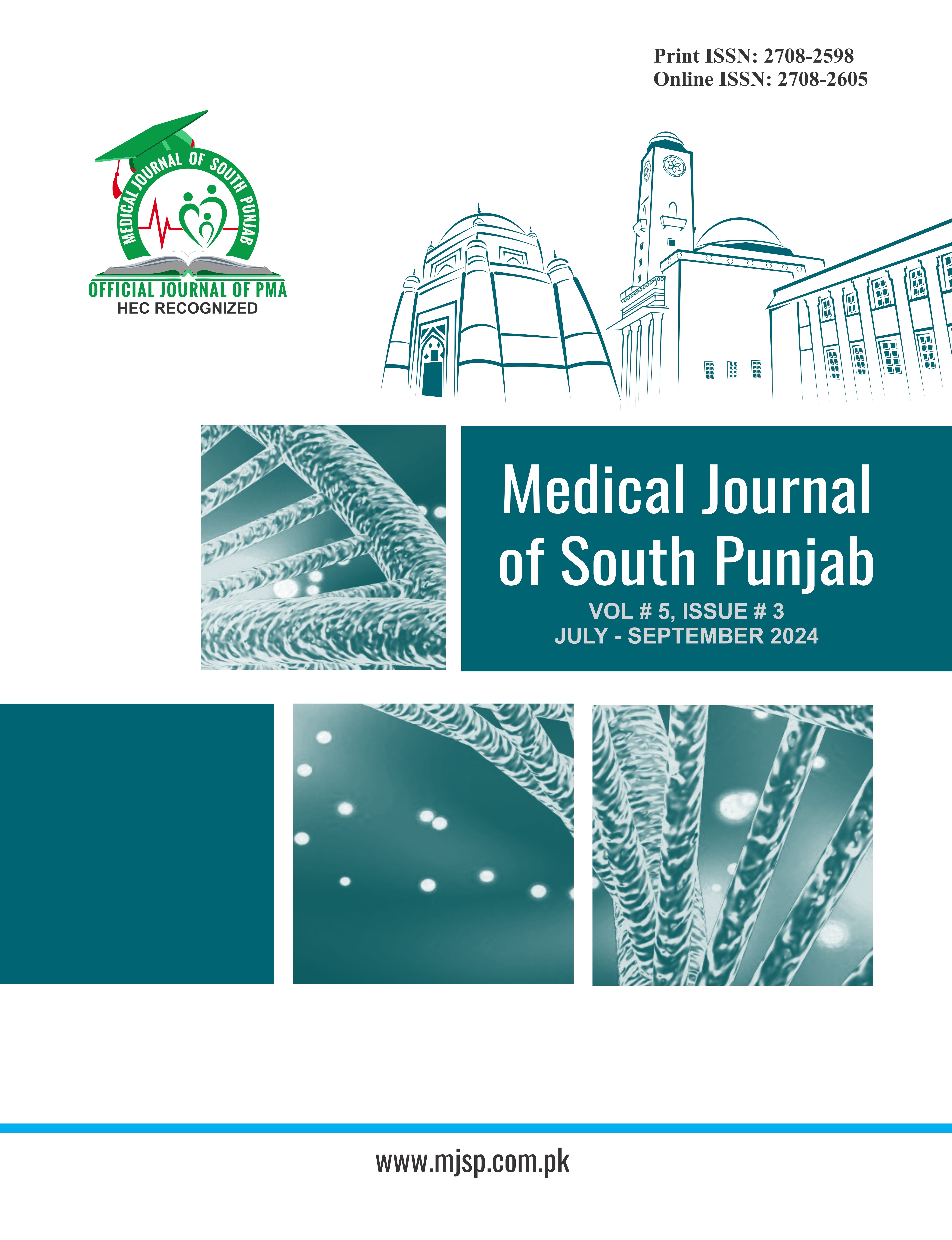Pattern of Mandibular Fractures Presenting in Maxillofacial Department of Tertiary Care Hospital.
DOI:
https://doi.org/10.61581/mjsp.v5i03.351Keywords:
Trauma, Pattern, Mandible fracture, Maxillofacial surgeryAbstract
Objective: This study will be conducted to evaluate the pattern of mandibular fractures presenting in maxillofacial department of tertiary care hospital.
Methodology: The study was conducted in the Department of Oral and Maxillofacial Surgery at Jinnah Postgraduate Medical Centre, Karachi, over a period of six months from December 2023 to June 2024, after the synopsis was approved. A validated questionnaire was used to collect demographic data, including age, gender, and residential status, as well as details regarding the etiology of the fracture (e.g., road traffic accidents, falls, assaults, sports injuries) and fracture characteristics (location, type, and complexity).
Results: Unilateral fractures 55.5% were more common than bilateral fractures 44.5%, with the angle 32.0% and body 26.5% being the most frequent fracture sites. Gender analysis showed no significant differences in fracture type (unilateral fractures: 53.5% in males vs. 60.7% in females, p=0.355) or fracture location (p=0.602), though males had a higher incidence of para-symphysis fractures 7.6% vs. 1.8%. Similarly, age stratification (18–40 years vs. 41–60 years) revealed no significant associations with fracture type or location.
Conclusion: Mandibular fractures are a fairly common injury in severe trauma, primarily affecting young males. The most frequent sites of fracture are the mandibular angle, followed by the body and the condyle, while symphyseal, parasymphyseal and ramus fractures are relatively rare.
Downloads
References
1. Devarakonda V, Navakoti P, Sungal RP, SakleshpurMruthyunjaya C, Karanam AK, Sanobar A. Trends in mandibular fracture patterns in central Telangana – A retrospective overview and analysis. Dental Traumatol. 2021;37:436–9.
2. Adik K, Lamb P, Moran M, Childs D, Francis A, Vinyard CJ. Trends in mandibular fractures in the USA: A 20-year retrospective analysis. DentTraumatol. 2023;39(5):425-36.
3. Gandhi S, Ranganathan LK, Solanki M, Mathew GC, Singh I, Bither S. Pattern of maxillofacial fractures at a tertiary hospital in northern India: a 4‐year retrospective study of 718 patients. Dental Traumatol. 2011;27(4):257-62.
4. Chaurasia A, Katheriya G. Prevalence of mandibular fracture in patients visiting a tertiary dental care hospital in North India. National JMaxillofac Surg. 2018;9(2):123-8.
5. Barsoum N, El-Wahed A, Nabil Helmi Y. Incidence, pattern, etiology of facial fractures among two referral centers (retrospective cross-sectional study). Egyptian J Oral Maxillofac Surg. 2024;15(2):27-47.
6. Pandey S, Roychoudhury A, Bhutia O, Singhal M, Sagar S, Pandey RM. Study of the pattern of maxillofacial fractures seen at a tertiary care hospital in north India. JMaxillofac Oral Surg. 2015;14:32-9.
7. Shakilur Rahman AFM, Haider IA. The pattern of mandibular fractures in Bangladesh: a 3-year cross-sectional retrospective study on 260 patients. Int J Scientific Res Dental Med Sci, 2021;3(1):1-5.
8. Monarchi G, Girotto R, Paglianiti M, Balercia P. A Single Center Experience: A Retrospective Study Over 10-Years Period on Mandible Fractures. CraniomaxillofacTrauma Reconstruct. 2024;17(3):232-7.
9. Mushtaq M, Gul S, Khattak YR. Frequency and common patterns of mandibular fracture: a cross-sectional study at tertiary care hospital at Peshawar. J Khyber CollDentistry. 2018;8(01):24-9.
10. Panesar K, Susarla SM. Mandibular fractures: diagnosis and management. SeminPlast Surg. 2021;35(4):238-49.
11. Hussain S, Ahmad M, Khan I, Anwar M, Amin M, Ajmal S, et al. Maxillofacial trauma: current practice in management at Pakistan Institute of Medical Sciences. J Ayub Med Coll Abbottabad 2003;15:8-11.
12. Mittal G, Mittal S. Mandibular fractures at veer Chandra Singh garhwali government medical science and research institute, Garhwal region, Uttarakhand, India: a retrospec-tive study. Ann Med Health Sci Res. 2013;3(2):161-5.
13. Kamali U, A. P. Mandibular fracture at HUSM: A 5-year retrospective study. Arch Orofacial Sci. 2009;4:33-5.
14. Atilgan S, Erol B, Yaman F, Yilmaz N, Ucan MC. Mandibular fractures: a comparative analysis between young and adult patients in the southeast region of Turkey. J Appl Oral Sci. 2010;18(1):17-22.
15. Lee KH. Epidemiology of mandibular fractures in a tertiary trauma centre. Emerg Med J. 2008;25(9):565-8.
16. Gaddipati R, Ramisetti S, Vura N, Reddy KR, Nalamolu B. Analysis of 1,545 Fractures of Facial Region-A Retrospective Study. Craniomaxillofac Trauma Reconstr. 2015;8(4):307-14.
17. Schneider D, Kämmerer PW, Schön G. Etiology and injury patterns of mandibular fractures in Germany. J Craniomaxillofac Surg. 2015;43(9):1776-81.
18. Iqbal S, Aslam A, Ahmed S, Khan N, Kashif M, Kazmi SM. Spectrum of mandibular fractures in a tertiary care hospital at Karachi. Int J Front Sci. 2020;4(2).61-4.
19. Krishnan S, Periasamy S, Arun M. Evaluation of patterns in mandibular fractures among South Indian patients. Bioinformation. 2022;18(6):566-71.
20. Samman M, Ahmed SW, Beshir H, Almohammadi T, Patil SR. Incidence and pattern of mandible fractures in the Madinahregion: a retrospective study. J Nat SciBiol Med. 2018;9(1):59-64.
Downloads
Published
Issue
Section
License
Copyright (c) 2024 Ahmad Sohail, Jehan Alam

This work is licensed under a Creative Commons Attribution 4.0 International License.
Authors retain copyright and grant the journal right of first publication with the work simultaneously licensed under a Creative Commons Attribution (CC-BY) 4.0 License that allows others to share the work with an acknowledgment of the work’s authorship and initial publication in this journal.







